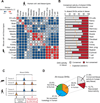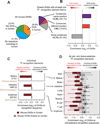Mouse regulatory DNA landscapes reveal global principles of cis-regulatory evolution
- PMID: 25411453
- PMCID: PMC4337786
- DOI: 10.1126/science.1246426
Mouse regulatory DNA landscapes reveal global principles of cis-regulatory evolution
Abstract
To study the evolutionary dynamics of regulatory DNA, we mapped >1.3 million deoxyribonuclease I-hypersensitive sites (DHSs) in 45 mouse cell and tissue types, and systematically compared these with human DHS maps from orthologous compartments. We found that the mouse and human genomes have undergone extensive cis-regulatory rewiring that combines branch-specific evolutionary innovation and loss with widespread repurposing of conserved DHSs to alternative cell fates, and that this process is mediated by turnover of transcription factor (TF) recognition elements. Despite pervasive evolutionary remodeling of the location and content of individual cis-regulatory regions, within orthologous mouse and human cell types the global fraction of regulatory DNA bases encoding recognition sites for each TF has been strictly conserved. Our findings provide new insights into the evolutionary forces shaping mammalian regulatory DNA landscapes.
Copyright © 2014, American Association for the Advancement of Science.
Figures





References
-
- Hardouin SN, Nagy A. Mouse models for human disease. Clin. Genet. 2000;57:237–244. - PubMed
-
- Mouse Genome Sequencing Consortium et al. Initial sequencing and comparative analysis of the mouse genome. Nature. 2002;420:520–562. - PubMed
-
- Lander ES, et al. Initial sequencing and analysis of the human genome. Nature. 2001;409:860–921. - PubMed
-
- Guénet JL. The mouse genome. Genom. Res. 2005;15:1729–1740. - PubMed
Publication types
MeSH terms
Substances
Grants and funding
- R37DK44746/DK/NIDDK NIH HHS/United States
- R01 DK096266/DK/NIDDK NIH HHS/United States
- 2R01HD04399709/HD/NICHD NIH HHS/United States
- R01 HD043997/HD/NICHD NIH HHS/United States
- U54HG007010/HG/NHGRI NIH HHS/United States
- P30 CA008748/CA/NCI NIH HHS/United States
- R37 DK044746/DK/NIDDK NIH HHS/United States
- U54 HG007010/HG/NHGRI NIH HHS/United States
- RC2 HG005654/HG/NHGRI NIH HHS/United States
- HHMI/Howard Hughes Medical Institute/United States
- MC_UU_12009/2/MRC_/Medical Research Council/United Kingdom
- 1RC2HG005654/HG/NHGRI NIH HHS/United States
- R01 EY021482/EY/NEI NIH HHS/United States
LinkOut - more resources
Full Text Sources
Other Literature Sources
Molecular Biology Databases
Miscellaneous

